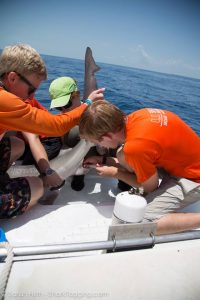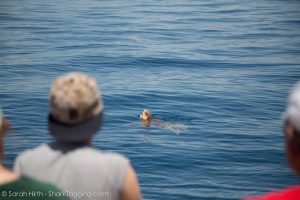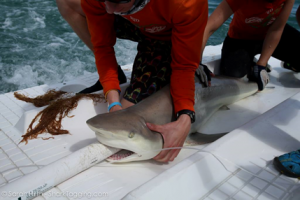Shark Tagging with Duke Alumni 6-20
by Laurel Zaima, RJD Intern
It was a beautiful Saturday to be on the water! As I drove over the Key Biscayne causeway, you could see the sun shining over the city. I knew it was going to be a great day to go shark tagging. After we loaded the boat with our equipment and the guests were all settled in, we were on our way! Duke Alumni were joining the RJD team for the shark tagging expedition, and they were all excited to become citizen scientists by helping us collect data for our shark research. Some of our guests have never seen a shark up close before, so our RJD team was equally as excited to share this experience with them.
Led by our RJD trip leader, David Shiffman, and Captain Eric, our enthusiastic RJD team for Saturday’s trip was Christian, Sam, Rachel, Rock, and myself. Cat, our professional photographer, took all the photos for this trip. After a 30-minute run from the marina in Key Biscayne to the offshore site, everyone was ready to set the gear and tag some sharks!
Once we arrived at our site, we deployed our first set of 10 drumlines with the help of our guests, and we let them soak for 1 hour. The waters were sharky because the first shark was caught on the second drumline! Unfortunately, the nurse shark wasn’t hooked in the jaw and ended up popping off the line. Instead of being discouraged, the RJD team and the citizen scientists were hopeful to catch more sharks on the upcoming drumlines. Sure enough, on the sixth line of the first set we caught a female Sandbar shark (2.03 meters total length)! After our team safely secured the Sandbar shark, the Duke Alumni enthusiastically helped to work up the shark, which includes a nictitating membrane reflex test, length measurements, a fin clip, and attaching a spaghetti tag.

Along side the Trip Leader, David Shiffman, and RJD intern, Laurel Zaima, South Florida Duke Alumni Club co-chair T.J. Morales got a chance to feel the rough dermal denticles of a Sandbar Shark’s skin
The RJD team collected the more advanced samples and data, such as blood and morphological measurements. The excitement didn’t die off there because on there was a shark on the following drumline! The seventh drumline had caught a female Nurse shark (2.52 meters total length). The RJD team and Duke Alumni were able to collect data swiftly and accurately, and the shark swam off in great condition.
The only thing you can 100% expect from fishing is that it will be unpredictable. Although our first set was full of action, our second set of drumlines didn’t catch a single fish. Luckily, we had our last set to give us 10 more chances to catch sharks!
The action picked up again on the last set of 10 drumlines. The second and third drumlines of the third set caught male Sandbar sharks (2.02 meters total length; 2.04 meters total length). Both of these male sharks were so close in size and were so similar; it felt like déjà vu. To end the day with a bang, the last shark that we caught on the seventh drumline was a Great Hammerhead shark! The male Great Hammerhead was the largest shark we caught all day at a whopping 2.63 meters total length. This shark was fighting on the line for a long period of time, so we decided to release the Hammerhead without a work up to ensure the health of the shark. The shark samples and data that we collect are important to the conservation of the species, but it is never worth risking the life of a shark. The Great Hammerhead ended up swimming off in great condition.
It was a perfect, summer, sharky day on the water! The Duke Alumni not only had an opportunity to see and feel a shark for the first time, but they also did a wonderful job helping our team collect shark data that will be used in upcoming research papers. The RJD team was very fortunate to go out with such an enthusiastic group, and we look forward to go shark tagging with Duke Alumni again!


























